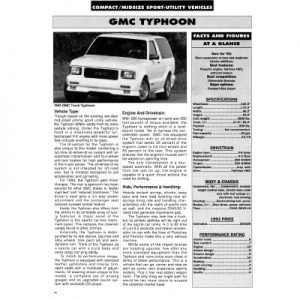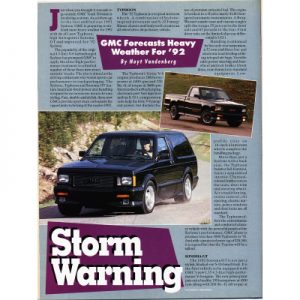Auto Sound & Security

When you look at the cars that are going around on the competition circuit these days you see a bunch of Hondas, Mustangs, T-Birds and (even though they only made a limited number of them) GMC Typhoons. The Typhoon was an instant hit with the press and with consumers from the day it took its turbocharged all wheel drive recipe from its big brother, the Syclone. Only problem was that it cost a lot more than the regular Jimmy, so sales never really took off.
But they’re a giant hit at soundoffs. So let’s say you’ve got one of these rarities and you realize there’s a whole bunch of them that have killer Systems in them. Some are even no-holds-barred systems because the truck belongs to a manufacturer. You’ve clearly got some work to do if you want to make yours stand out in the crowd.
Adam Saruwatari of Arroyo Grande, California, had just this situation when he decided to have a competition system installed in his ’93 Typhoon. Initially he was happy just to race around smokin’ all the dudes who didn’t know what the Typhoon was, but then his dad developed an ear for quality sound and that’s where the trouble started.
In an unbelievable maneuver, Adam’s dad, Leroy, said he’d sport for half the bill on the truck’s new system. Well now, let me think. I can spend twice as much; that shouldn’t be any trouble. So for help he went on over to Lombard’s Stereo in Santa Maria. Mark Baker and Dario Bognuda helped to lay out a system that was based on only two amps but had plenty of show to wow the judges with.
Once everything was laid out it was time to tear into that turbo machine like Adam tears into those unsuspecting Corvettes. Dario started under the hood where the factory alternator was rewound to put out 120 amps, and then all the electrical wiring was run. Street Wires power distribution blocks and circuit breakers feed into more Street Wires power cable. For juice a pair of Optima 800-6 volt batteries were wired in series.
Inside the cab things look simple, but the more compartments you start to open the more things you discover. The dash holds an Alpine 1310 CD changer controller. Since it doesn’t have a lot of depth it was easy to flush mount, so it doesn’t stick out like in most GM mini trucks. The stock dash locations were filled with a MB Quart QM 100 MX 4-inch mid and QM 19.01 HX dome tweeter.
The factory door panels have no spot for speakers; Dario went ahead and made himself one, In a super slick maneuver he flush mounted a pair of MB Quart OM 160 TX 6.5-inch midbasses in each door, The panel that runs along the entire bottom half of the door doesn’t stick out at all and the grill cloth was even mounted from behind. The look is even better than stock.
The Typhoon has a large center console and an overhead console. Just lookin’ at Dario you know he’s gunna put stuff in both. In the back of the center console he managed to flush mount an Alpine 5957 CD changer. Towards the front where the cup holders used to be is the command center of the system. A black on white panel with 28 red/green LED’s and three LCD displays tell Adam if everything is operational. The LCDs are for all the fuses and amps and the alarm while the LED panels show system voltage, interior temperature and amplifier temps. Dario estimates just that part took about 50 hours to complete.
Dario’s next trick was to put in a couple of small tweeters on the back side of the rear view mirror. The mirror is the kind that has little map lights in the bottom of it. Rockford SPT14s were grafted into the back and aimed at about a 20 degree angle. Even though the tweeters are extremely small, the light reflectors and bulbs had to be reworked so the lights would still function. To get all that to work was another 16 hours.
The overhead console had a couple of hidden storage compartments where Dario hid a few goodies. In the one closest to the front Dario disassembled an Alpine deck and pilfered its six radio preset buttons. The buttons were then wired in parallel with the controls on the Alpine 3681 electronic crossover that was in the back. The buttons were mounted from the rear, so unless you know what you’re doing you can’t operate the buttons.
Further back, the same style keypad for an Alpine 8080 alarm system was mounted. You just slide a button and a panel pops open to show you the keypad. In the same area is a switch for the fan that cools the amp section, and some micro switches run a motor that spins the dial on a power fader.
Dario needed a power fader because he made the system’s rear fill work off a single Rockford Fosgate Punch 60. The rear fill is exactly the same MB Quart drivers that are in the front dash locations. The power fader lets Adam adjust just how much rear fill he wants with the touch of a button in the overhead console, even though there’s only one amp.
Pop the hatch button and you get an eyeful of car stereo. About half of the back’s space is taken for tunes; but if what you see is what you get then I’ll take it. A giant Plexi-backed enclosure with white Formica inside stares you in the face. Inside the enclosure are the obvious subs; a pair of JL Audio 10W1s. One on the left side of the box and the other on the right. They’re mounted backwards so you see the cone and listen to the backside, but it looks better that way.
What’s not obvious about the box is the electronics inside of it. The Alpine 3681 Digital Max processor/EQ sits in there along with an Alpine 3402 7-band EQ. The 3402 is normally 3 bands front and 4 bands rear, but again since there’s only one amp, it was set for a non-fading 7 band equalizer. A Punch 40 and Punch 60 with the Link lay flat just in front of that. All this is inside the sub box!
Little pockets to the left and right display a stiffening capacitor and the system’s fuse block. The top of the enclosure also has a Plexiglas top with vents on either side of it for the JL Audio sub’s output to escape. Even though it takes quite a hit of room and probably slows this red-light racer down a bit, Adam says it’s totally worth it.
Adam has the full support of his father (obviously, he paid for half the system) who even comes along with him to some of the closer shows. To make sure he gets off on the right foot, Adam’s installer Dario also makes the trip because he loves this install like it was one of his kids. Can you blame him?





